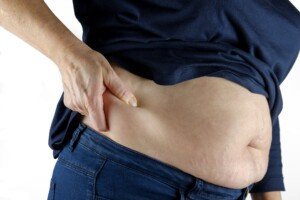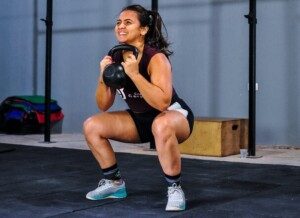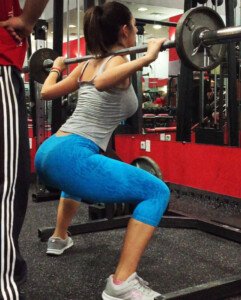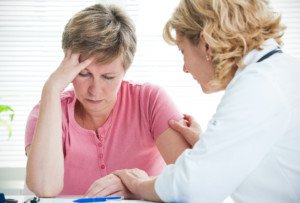PCOS symptoms vs. perimenopause and aging: And can the onset of PCOS first appear only after menopause? Weight gain, irregular periods, fertility issues…
PCOS stands for polycystic ovarian syndrome: a compilation of symptoms that also includes hair loss on the scalp.
A postmenopausal woman may begin experiencing symptoms that seem to strongly resemble those of PCOS.
Now of course, one of the consequences of PCOS is irregular menstruation and issues with fertility. These issues won’t apply to a postmenopausal woman.
But other symptoms of PCOS are: excessive hair growth on the face, oily skin, acne and weight gain.
“PCOS presents in women after puberty, typically in the late teens and 20s,” says Karen Patrusky, a board certified OBGYN and F.A.C.O.G. in private practice for 20+ years.
“The most common presenting symptom is irregular periods.
“Women who are trying to get pregnant and are experiencing fertility issues may be worked up by their physician and then receive the diagnosis of PCOS.
“This diagnosis is usually achieved by evaluating hormone levels as well as a sonogram of the ovaries.
“Additionally, women with PCOS can notice acne and oily skin, unwanted hair growth, impaired glucose tolerance and issues with metabolism.
“Sometimes in the perimenopause, or the years preceding menopause, these symptoms can be confusing or overlapping.
“As women get older periods can become irregular; weight issues and glucose control can become problematic as well.”
Can the onset of PCOS ever, at all, first develop after menopause?
Dr. Patrusky explains, “PCOS is a condition that typically develops at some time during a woman’s reproductive years — onset in puberty until menopause.
“It does not have its onset after menopause.
“Symptoms of perimenopause, irregular menstruation, weight and metabolic issues and fertility issues can mimic many of the symptoms of PCOS.
“Both of these conditions, however, are due to hormonal shifts — but are different.”
Weight Gain Before and After Menopause

Whether you have PCOS (premenopause) or the so-called age-related weight gain after menopause is completed, there are things you can do to combat this unwanted accumulation of fat – things that you may not have ever even considered.
“Maintaining a well-balanced diet, low in carbs, and regular exercise is imperative,” begins Dr. Patrusky.
“With PCOS aerobic and fat burning exercise is going to help with metabolic management.
“With the older women aerobic activity is important as is weight bearing exercise for bone health and stretching to maintain joint health as well.”
But what if you’re already taking these measures but the weight gain either continues, or the excess fat just won’t come off?
Chances are pretty high that there’s plenty of room in your plan for tweaking.
Weight Won’t Budge: Check Yourself for These Mistakes
Strength training. If you’re already doing this, make sure it focuses on big moves, not little moves.
This means an emphasis on pulling and pressing motions, and only secondary to that, flexing and extending motions.
In other words, do five sets of deadlifts and bench presses rather than five sets of arm curls and triceps kickbacks.
Do six sets of some type of weighted squat and six sets of leg presses, rather than five sets on the inner and outer thigh machines.
The images below show some great fat-burning strength training exercises.

Weighted squat. Pexels/Cleiton silv

Weighted squat. Freepik.com, teksomolika

Weighted squat

Deadlift. Preparing to pick up the barbell.

Almost complete with the deadlift; completion is when the back is straight. Freepik.com

Lat pull-down. Shutterstock/sklyareek

Horizontal leg press. Freepik

Overhead press. Freepic.com, master1305
Treadmill. If you use a treadmill, do you hold on? This creates a false sense of calorie burn, despite what the computer readout shows.
Holding on burns about 20% fewer calories. If you can’t seem to break this sabotaging habit, here’s how.
Go HIIT! Even if you haven’t been holding onto the treadmill, or are using other cardio equipment and still not seeing results, you should try HIIT: high intensity interval training.
Rather than go at a fixed, prolonged pace, HIIT employs mixing brief but very intense effort with casual relaxed effort.
This has a greater fat burning effect than fixed pace, steady state cardio. Here’s how HIIT works.
Finally, whether you have PCOS or postmenopausal weight gain, NEVER cancel a planned workout just because you ate too much.
Being faithful to your workout regimen is crucial for building bone and joint strength, feeling young rather than old, and reducing the risk of heart disease and some cancers.
Dr. Patrusky is the developer of Voila Intimate Mood Oil, a 100% organic, non-hormonal lubricant made from coconut oil infused with the purest natural herbal oils. All five formulas are vegan, cruelty-free and U.S. produced. Voilamoodoil.com
 Lorra Garrick is a former personal trainer certified by the American Council on Exercise. At Bally Total Fitness she trained clients of all ages for fat loss, muscle building, fitness and improved health.
Lorra Garrick is a former personal trainer certified by the American Council on Exercise. At Bally Total Fitness she trained clients of all ages for fat loss, muscle building, fitness and improved health.
.











































